

The Harlem Renaissance has also been called the "New Negro Movement" after the title of art historian Alain Locke’s book The New Negro, which urged black artists to reclaim their ancestral heritage as a means of strengthening their own expression.
Examples of their visual works:
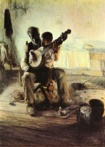
Henry Ossawa Tanner (American, 1859-1937),
The Banjo Lesson, 1893, 49 x 35 1/2 inches, oil
on canvas, Hampton University
Museum, Hampton, Virginia.

Henry Ossawa Tanner, The Seine, c. 1902, oil on canvas, .228 x .330 m (9 x 13 inches), National Gallery of Art, Washington, DC.

Meta Vaux Warrick Fuller (American, 1877-1968), Ethiopia Awakening, bronze.
James Van Der Zee (American, 1886-1983). See photography.
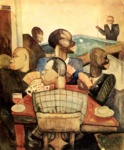
Palmer Hayden (American, 1890-1973), Nous Quatre a Paris (We Four in Paris), no date, watercolor on paper, Metropolitan Museum of Art,
NY.
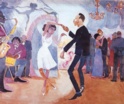
Palmer Hayden, Jeunesse, no date, watercolor on paper, 14 x 17 inches, collection of Dr. Meredith F. Sirmans, NY. This and works by many other artists the Harlem Renaissance were influenced by their enjoyment of jazz, an often improvisational musical form developed during the 1920s by African Americans and influenced by European harmonic structure and African rhythmic complexity. Jazz can be identified by its characteristic blues rhythms and distinctive speech intonations. Harlem has long been an important center for jazz. Palmer Hayden could have seen such dancing as this at the Savoy, which was Harlem's most famous jazz club.

Archibald J. Motley (American, 1891-1981), Mending Socks, 1924, oil on canvas, Ackland Art Museum, U of North Carolina at Chapel Hill.

Archibald J. Motley, Blues, 1929, oil on canvas.
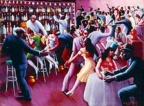
Archibald J. Motley, Nightlife, 1943, oil on canvas,
91.4 x 121.3 cm, Art Institute of Chicago, IL.

Augusta Savage (American, 1892-1962), Gamin, 1930, bronze.

Dox Thrash (American, 1892-1965), Railroad Yard, c. 1933-1934, aquatint, etching and pencil on paper, 5 x 3 7/8 inches (12.7 x 9.9 cm), Smithsonian American Art Museum, Washington, DC.

Dox Thrash, East Side, 1939, aquatint on wove paper, 9 7/8 x 7 7/8 inches (25.1 x 20 cm),
Pennsylvania Academy of the Fine Arts, Philadelphia, PA.
Malvin Gray Johnson (American, 1896-1934)

Aaron Douglas (American, 1898-1979), Sahdji, c. 1925, ink and graphite on wove paper, 12 1/16 x 9 inches.

Aaron Douglas, Study for Aspects of Negro Life: The Negro in an African Setting, 1934, gouache on Whatman artist’s board, 37.1 x 40.6 inches, Art Institute of Chicago, IL. Aaron Douglas's paintings show that he was particularly influenced by ancient Egyptian sculpture and the modern Art Deco style.

Aaron Douglas, Into Bondage, 1936, oil on canvas, 60 3/8 x 60 1/2 inches (153.35 x 153.67 cm), Corcoran Gallery, Washington, DC.
Hale Woodruff (American, 1900-1980)
Richmond Barthé (American, 1901-1989), Feral Benga (Benga: Dance Figure), 1935, bronze, Museum of Fine Arts, Houston, TX.
Selma Burke (American, 1901-1995)
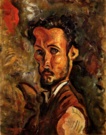
William Henry Johnson (American, 1901-1970), Self-Portrait, 1929, Smithsonian Museum of American Art, Washington, D.C. See self-portrait.

William H. Johnson, Chain Gang, Smithsonian Museum of American Art, Washington, D.C.
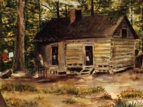
Loïs Mailou Jones (American, 1905-1998), Negro Shack I, Sedalia, North Carolina, 1930, watercolor on paper, 15 x 20 inches.

Loïs Mailou Jones,
Fishing Smacks, Menemsha, Massachusetts, 1932, watercolor on paper, 20 1/4 x 26 1/2 inches.
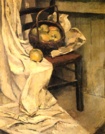
Loïs Mailou Jones, Les Pommes Vertes (The Green Apples), 1938, oil on canvas, 36 x 28 1/4 inches. This picture was exhibited at the Société des Artistes Français, Paris, 1938.

Loïs Mailou Jones, Jennie, 1943, oil on canvas, 41 3/4 x 34 inches.
Charles Alston (American, 1907-1977)
Romare Bearden (American, 1914-1988)
Visit the Romare Bearden Foundation and "Let's Walk the Block," about Romare Bearden's 6-panel 1971 collage, The Block at the Metropolitan Museum of Art, New York.
Jacob Lawrence (American, 1917-2000), The Migration of the Negro: Panel No. 57, 1940-41, tempera on Masonite, 18 x 12 inches, Phillips Collection, Washington, D.C. See American Scene painting.

Jacob
Lawrence, Pool Parlor, 1942, gouache on paper,
31 x 22 3/4 inches (78.7 x 57.8 cm), Metropolitan Museum of Art,
NY.
Jacob Lawrence, The Library, 1960, tempera on fiberboard, 24 x 29 7/8 inches (61.0 x 75.9 cm), National Museum of American Art, Washington, DC.
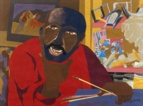
Jacob Lawrence, Self-Portrait, 1977, gouache on paper, 22 1/8 x 30 inches, National Academy of Design, NY.
John Biggers (American, 1924-)
Samella Lewis (American, 1924-)
Sam Gilliam (American, 1933-)
Also see African
art, Afrocentrism,
and ethnic.
https://inform.quest/_art